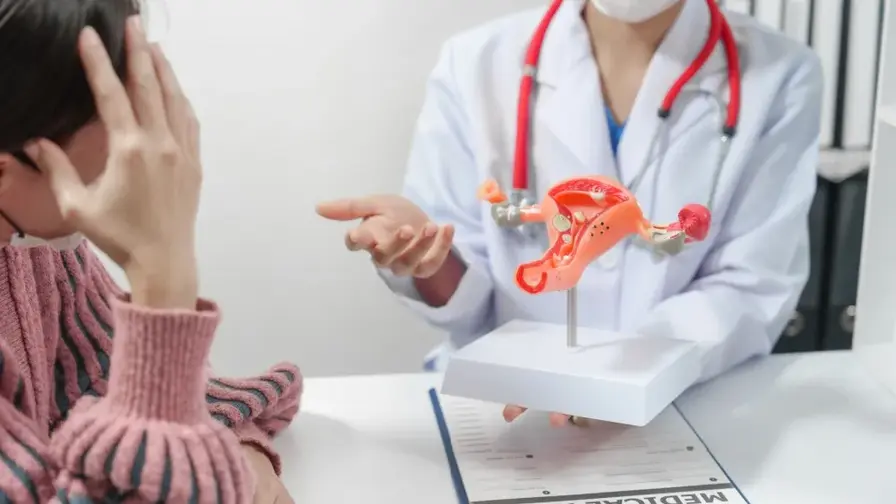Frequent night sweats and hot flashes when the cold snap hits? The combination of 10 major symptoms may be a warning sign of "neuroendocrine tumors"

Frequent night sweats and hot flashes when the cold snap hits? When he checked, he found that there was a 9 cm tumor in his body.
When a cold wave hits, hot flashes and night sweats increase instead of abating. Symptoms such as diarrhea, coughing, and constant hunger last for several months. Could this be a warning sign of “cancer”? Dr. Jiang Nairong, deputy secretary-general of the Cancer Medical Society of Taiwan and Department of Oncology, Taipei Veterans General Hospital, said that there was a male patient who was a first-level supervisor in the information industry and began to experience symptoms such as hot flashes and cold sweats while sleeping 7 years ago. , the health examination was thought to be pancreatic cancer, but the tumor index and computer tomography imaging showed normal, so I thought it was a false alarm. Unexpectedly, this condition is a precursor to a rare cancer: “neuroendocrine tumor”.
After a delay of 3 years, the patient’s symptoms of hot flashes and night sweats worsened, and he also developed shoulder and back pain and tea-colored urine. An 8-9 cm liver tumor was found during examination. Hepatocellular carcinoma was once suspected, but the fetal protein A value showed It was normal. After being alerted to the abnormality, I went to a large hospital for detailed examination and was finally diagnosed as “gastroenteropancreatic neuroendocrine tumor combined with liver metastasis.”
Upon diagnosis, the patient immediately took active treatment. After three years of multiple hormonal treatments, four liver embolizations, and two surgeries, a 17-centimeter long wound was left on the abdomen, but it still could not prevent the recurrence of cancer cells. Therefore, he took the initiative to consult the medical team and received precise targeted radiation therapy at the beginning of the year, which successfully stopped the neuroendocrine tumor. During this period, the tumor not only shrank, but his physical discomfort also “feel less”, and he finally regained his former healthy life.
The number of people has increased by 13 times in 20 years! Pay attention to the top ten symptoms of neuroendocrine tumors
Dr. Jiang Nairong pointed out that neuroendocrine tumors are malignant tumors caused by excessive secretion of hormones by “neuroendocrine cells”. According to the latest cancer registration data from the Taiwan Ministry of Health and Welfare, there are approximately 1,219 new cases in Taiwan. Although the number is small, research shows that the number of diagnosed cases has increased rapidly by about 13 times in the past 20 years, far exceeding the growth rate of liver cancer in the same period of 1.29 times. , lung cancer 1.56 times, intestinal cancer 1.83 times and breast cancer 2.75 times. Therefore, we call on the public to pay more attention to both common cancers and rare cancers such as neuroendocrine tumors.
In particular, neuroendocrine tumors may occur in “more than 17 organs throughout the body”, and symptoms vary depending on the location of the disease. Difficulties in early diagnosis cause delays. Statistics show that it takes an average of 6 years for patients to be diagnosed from onset of disease, and 50% of patients have already developed tumor metastasis when diagnosed, making treatment more complicated.
Dr. Jiang Nairong reminded that among all organs, the most common primary sites of neuroendocrine tumors are the “stomach, pancreas, and intestines”, with a proportion of about 50-60%. Apple founder Steve Jobs suffered from pancreatic cancer. He died of neuroendocrine tumors at the site. If people experience the ten warning signs for no reason, such as hot flashes, night sweats, low blood sugar hunger, diarrhea, recurrent gastric ulcers, fever, cough, asthma, palpitations and dermatitis, etc., and the symptoms last for several months, they should seek medical attention as soon as possible. Details examine.
Break through the treatment bottleneck of no new drugs for a long time! Neuroendocrine tumors require multiple weapons to fight cancer
Chen Lizong, Chairman of the Taiwan Neuroendocrine Tumor Society, said that the main treatment for neuroendocrine tumors is surgical resection of the lesions. Those who cannot undergo surgery can be given appropriate drug treatment, including chemotherapy, hormonal treatment, and standard treatment, depending on the severity of the disease, the location of the tumor, and whether it has metastasized. Target therapy and precision radiation target therapy, etc.
Chairman Chen Lizong explained that there has been no significant progress in the drug treatment of neuroendocrine tumors for many years. After traditional targeted therapy fails, patients can only receive repeated chemotherapy and hormonal treatments. Not only is the improvement effect limited, but patients also suffer from long-term travel to and from the hospital. The quality of life is deeply affected by the fatigue of traveling and traveling. However, with the advancement of medicine, there are now options for precise radiation targeted therapy, which can help shrink neuroendocrine tumors of the stomach, intestines, and pancreas, bringing new hope to patients.
“Nuclear Medicine Precision Treatment” two-in-one feature accurately kills neuroendocrine tumor cells
“Nuclear medicine precision treatment”, also known as “nuclear medicine diagnosis and treatment in one”, is a new generation of precision radiation targeted therapy. Wang Yufeng, chairman of the Nuclear Medicine Society of Taiwan and Department of Nuclear Medicine, Taipei Veterans General Hospital, said that precision nuclear medicine treatment has the characteristics of “diagnosis” and “treatment” in one:
“Diagnosis” refers to a compound drug that combines a target with a radioactive isotope. After being injected into the human body, it can be used with nuclear medicine photography and scanning to accurately locate cancer lesions, helping clinicians to make correct cancer staging and plan the best personal treatment. plan. “Treatment” involves introducing the drug’s radioactive isotopes into tumor tissue to accurately kill tumor cells.
Compared with traditional treatment methods, the radioactive isotopes combined in the new generation of nuclear medicine precision treatment can simultaneously emit gamma rays required for imaging scanning and particles (alpha or beta particles) that eliminate tumor cells, thus achieving the goal of diagnosis. At the same time, it can provide precise treatment, and at the same time, the distribution of the drug can be clearly seen. Provides multi-faceted clinical applications covering diagnosis, treatment planning, tumor elimination and follow-up.
Chairman Wang Yufeng pointed out that in recent years, precision nuclear medicine diagnosis and treatment has been gradually used in the diagnosis of various cancers, such as detecting the location of tumors before treatment, distinguishing between benign and malignant tumors, and diagnosing the possibility of tumor recurrence and distant metastasis; in Cancer treatment applications include neuroendocrine tumors, prostate cancer, liver cancer, lymphoma, thyroid cancer and bone metastases.
Taking gastroenteropancreatic neuroendocrine tumors as an example, in the past, it was usually only possible to maintain disease progression for 2-3 years after treatment. However, now patients who have failed hormonal therapy and receive precise nuclear medicine treatment have the opportunity to maintain disease stability for a longer period. Overall The survival period may also exceed 4 years.
The patient group hopes that all walks of life will pay attention to neuroendocrine tumors and provide more therapeutic weapons to help prolong lives.
Lin Zhisheng, Chairman of the Taiwan Neuroendocrine Tumor Patients Care Association, said that the incidence of neuroendocrine tumors is low and it is a rare disease. It has many early symptoms and is difficult to diagnose, so it is easy to be ignored. He hopes that through this event, we can help More people are aware of neuroendocrine tumors and are more alert to the signs of the disease for early detection and treatment.
Once a neuroendocrine tumor is diagnosed, you should contact the association as soon as possible to help understand the disease and help fight the disease together. Zhou Fangting, a neuroendocrine tumor patient himself and secretary-general of the Taiwan Neuroendocrine Tumor Patients Care Association, said that most neuroendocrine tumor patients are in middle age. If early and effective treatment can be carried out to control the disease, it will not only help the patients regain their health. The opportunity is also an important productivity that helps the family’s economic backbone and contributes back to the country and society.
However, the research and development of new drugs for neuroendocrine tumors is progressing slowly. Many patients will take the initiative to consult doctors after searching for information on new drugs on the Internet, only to find that compared with other advanced countries, Taiwan’s introduction and health insurance payment are slow. If patients wait too long without more effective treatment, the disease will continue to worsen. We hope that the government, based on protecting the health of the people, will pay equal attention to both major and minor cancers and provide more and newer treatment options to reduce the physical and mental burden on patients.
Extended reading:





